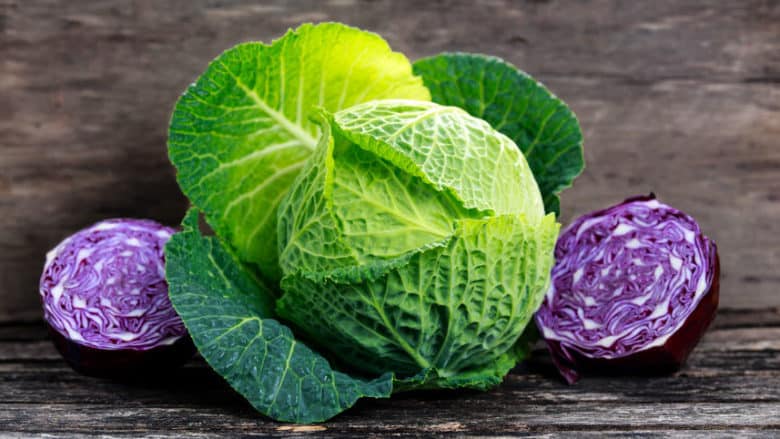
Cabbage benefits come from the whole cabbage family (Broccoli and cauliflower may not seem like cabbage family members, but they are!):
The Cabbage Family
- Broccoli
- Cabbage
- Turnip
- Brussels sprouts
- Cauliflower
- Kohlorabi
- Bok choy
- Watercress
- Collards
- Kale
- Mustard greens
- Rutabaga
The cabbage family vegetables are called cruciferous based on the cross-like shape of their flower buds (cruciferae, in New Latin means “cross-bearing”).
They have special health benefits that make it important to include them as a regular part of your diet.
For instance, a study of 5,000 women in China diagnosed with breast cancer found that women who consumed the most cruciferous vegetables were 62 percent less likely to die of breast cancer and 35 percent less likely to have a recurrence of the disease, compared with those who consumed the least.
Cabbage family vegetables eaten by the women were mustard and turnip greens, bok choy, cauliflower, and green cabbage.
Here’s a sampling of special cabbage benefits that contribute to natural healing and definitely make them a healthy food.
Cabbage Benefits
1. Natural Detoxifiers
Cruciferous vegetables have thousands of phytochemicals, some of which enhance the effectiveness of the body’s main detoxification system: the liver’s phase I and phase II enzyme systems.
A 2004 French study found that the juice from watercress significantly increased these enzymes.
These enzymes help transform harmful toxins and carcinogens into harmless compounds that can be safely eliminated by the body.
2. Antibiotic Actions
One of the key antibiotic actions related to broccoli benefits is its effect on Helicobacter pylori (H pylori). H. pylori infects cells in the lining of the stomach causing gastric ulcers (also known as peptic ulcers) and gastritis.
This infection is painful and may cause bleeding, it also can lead to stomach cancer if left untreated. H. pylori is resistant to antibiotics, it may take a number of them to stop their destructive process.
Through animal studies, sulforaphane, a substance in broccoli and broccoli sprouts, was found effective in fighting Helicobacter infections and blocking gastric tumor formation.
The study authors say their findings, “offer hope that these mechanisms might function synergistically to provide diet-based protection against gastric cancer in humans.”
See the Proceedings of the National Academy of Sciences.
3. Healthy Estrogen Metabolism
Adults may develop an imbalance in estrogen metabolism with certain types of estrogen becoming more likely to trigger cancer. It is estimated that about 40% of all cancers in women are hormonally mediated.
Elevated estrogen metabolites were also found to be linked to an increased risk of prostate cancer in men.
Further, a study found organochloride xenoestrogens increase breast cancer risk. These estrogens mimic the body’s natural estrogens and are ingested and absorbed from plastics, industrial chemicals, and pesticides (like PCBs or polychlorinated biphenyls).
Cruciferous vegetables contain compounds that promote a healthier pathway for breaking down estrogen in the body, thus protecting against cancer. They may also protect against the growth and spread of existing cancers through many other mechanisms.
4. High Fiber
The cabbage family’s high fiber content make them a good choice for lowering cholesterol.
5. Anti-inflammatory
Rich in vitamins and minerals that act as antioxidants as well as other plant compounds, these vegetables help fight oxidative stress to reduce free radicals and inflammation in the body.
How to Get the Most Cabbage Benefits
You can get the most out of cabbage benefits by eating these vegetables raw or cooking them with quick cooking methods such as steaming, sautéing, or stir frying.
Steaming is a better cooking method than microwaving if you want to maximize the health benefits of glucosinolates found in cabbage, says George Mateljan at The Worlds Healthiest Foods.
Key Cabbage Benefits
Cabbage benefits come from the whole cabbage family. Include some of these vegetables in your diet everyday as they may help vexing health concerns like gastric ulcers and cancer.
They are best cooked over a short time with methods like steaming or eaten raw. Enjoy cabbage benefits today!
Cabbage Benefits Sources and Resources
Bradfield CA, Bjeldanes LF, “Modification of carcinogen metabolism by indolylic autolysis products of Brassica oleraceae,” Advances in Experimental Medicine and Biology, 1991;289:153-63.
Fahey JW, Haristoy X, Dolan PM, et al. Sulforaphane inhibits extracellular, intracellular, and antibiotic-resistant strains of Helicobacter pylori and prevents benzo[a]pyrene-induced stomach tumors, Proceedings of National Academy of Science, 2004; 99:7610-15.
Lhoste EF, et al, “The activities of several detoxication enzymes are differentially induced by juices of garden cress, water cress and mustard in human HepG2 cells,” Chemico-Biological Interactions, 2004 Dec 7;150(3):211-9.
Mateljan, George, The Wold’s Healthiest Foods, http://www.whfoods.org.
MedlinePlus, Health Day, “Veggies Like Broccoli, Cabbage May Help Fight Breast Cancer: Study,” http://www.nlm.nih.gov/medlineplus/news/fullstory_123681.html. April, 2012.
Starek A, “Estrogens and organochlorine xenoestrogens and breast cancer risk,” International Journal of Environmental Medicine and Occupational Health,” 2003;16(2):113-24.
Zhang, Y and Callaway, E, “High cellular accumulation of sulphoraphane, a dietary anticarcinogen, is followed by rapid transporter-mediated export as a glutathione conjugate,” Biochemical Journal, 2002 May 15; 364(Pt 1): 301–307.
